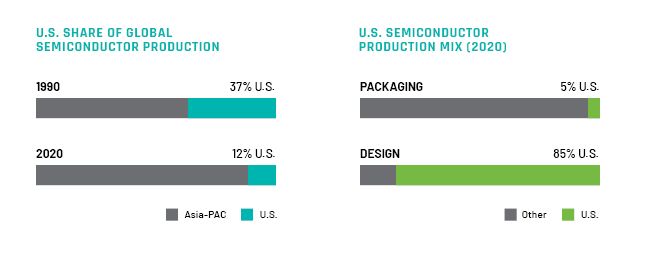
CHIPS Part 1: National security and the state of domestic chip manufacturing
March 8, 2023
The recently signed Creating Helpful Incentives to Produce Semiconductors and Science bill, also known as the CHIPS and Science Act of 2022, could help transform the future of defense and aerospace technology. Over a series of blogs, we examine the state of U.S. chip manufacturing, the role microelectronics have in the future of defense, how the new legislation is a first step toward a long-term, sustainable supply of semiconductors and additional steps we might take to help solve multiple challenges across industry and time horizons.
Integrated circuits. Microprocessors. Computer chips. Although semiconductors come in many forms and with many names, they all have one thing in common: they have transformed — and will continue to transform — the way we live, work and defend our nation. But as we have come to increasingly rely on these innovations, we have followed a technological path that could lead to a risky and dangerous future. Far from the warnings of science fiction, the reasons for this are familiar and as old as recorded history: trade and politics.
The defense risks of relying on an international supply chain
From the semiconductor’s invention and use in the Apollo 11 guidance computer to the advancements of Silicon Valley, the United States has a long history of leading the way when it comes to silicon-based computing chips. This innovation continues today, with approximately 85% of all global chips designed in the country. However, when it comes to manufacturing and packaging chips, concerns over labor costs and affordability have resulted in the U.S. giving way to other nations, mainly China and Southeast Asian countries.
The U.S. produced 37% of the world’s semiconductors in 1990 but now produces just 12% of the world’s chips. The U.S. also performs packaging — the final stage of semiconductor fabrication — on only about 5% of the global supply.
When viewed through a national security lens, the data paints a picture of a potential disaster waiting to happen. From backdoor installations to shipping issues to international disputes, the U.S. semiconductor supply chain becomes more vulnerable with every country a semiconductor is exposed to on its production journey. Take, for example, the following:
- The combination of an increased global demand for smart electronics, modern chip-hungry automobile designs, and the closing of factories due to COVID-19 caused a major global chip-supply shortage of which the effects are still being felt.
- Taiwan is the world’s largest producer of advanced microchips, and its factories have fabrication capabilities that don’t exist anywhere else in the world. A conflict or blockade of the island could put these globally important facilities at risk of destruction or takeover.
- The U.S. had to lobby the Netherlands’ government to reverse course and block the agreed-upon sale of Dutch chip-manufacturing technology to China. Had the sale gone through, it would have given China the ability to make the world’s fastest microprocessors and eliminated an advantage enjoyed by the U.S. and its allies.
- The conflict between Russia and Ukraine cut the worldwide supply of neon in half and sent prices soaring. Ukraine is a leading exporter of the gas, which is critical to the process of semiconductor manufacturing.
- Concerns over the ability of China to use Chinese-made chips to spy on Americans has led to a ban on U.S. sales of certain devices and equipment.
The growing need for chips and the future of defense
The growth of a secure and low-risk domestic supply of semiconductors is key to long-term U.S. defense for numerous reasons beyond potential supply-chain disruptions. That’s because the increasing demand for systems-on-a-chip; connected, rugged processing and sensor components; artificial intelligence; and machine learning are taking the defense industry toward a new technological age of microelectronics. Read the second blog in our series to learn more about this vision, one in which almost everything will be done at the chip level.
Mercury Systems is supporting the development of trusted, onshore microelectronics for operation at the edge of defense.
Read the second blog in the series: Microelectronics and the future of defense platforms







 Raising the bar: Why cross-domain solutions are critical to data security
Raising the bar: Why cross-domain solutions are critical to data security Processing convergence: Advanced, agile defense electronics technology
Processing convergence: Advanced, agile defense electronics technology